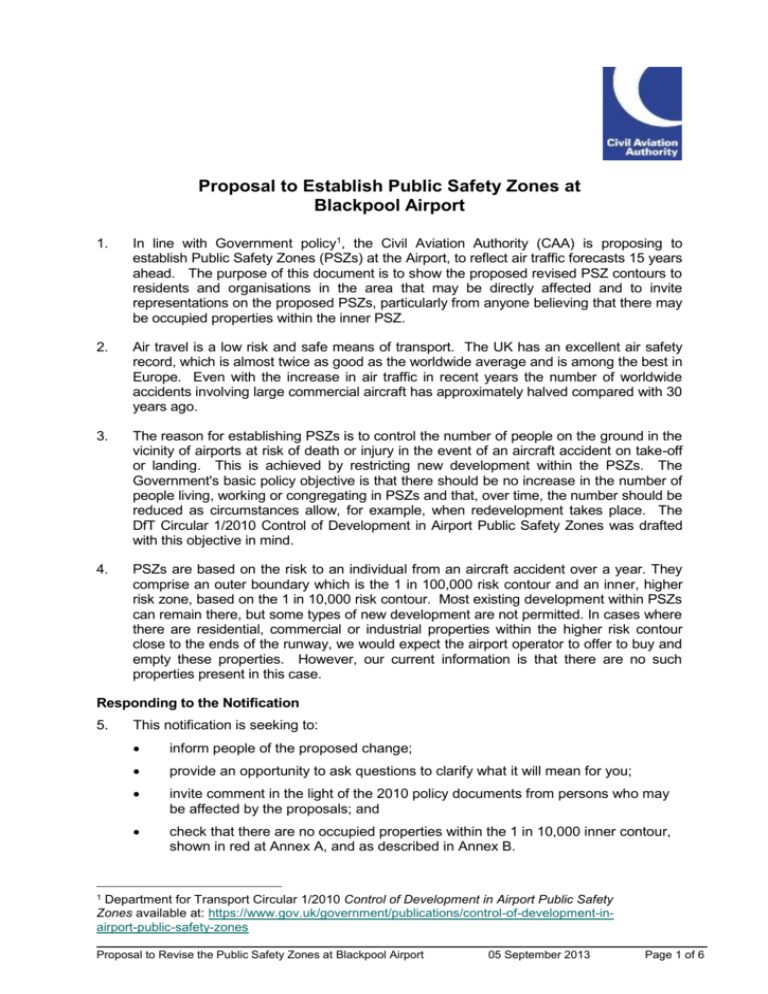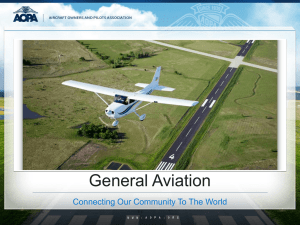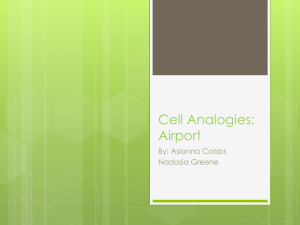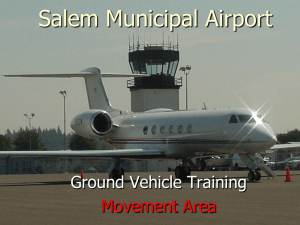Proposal to Revise the Public Safety Zones at Bournemouth Airport
advertisement

Proposal to Establish Public Safety Zones at Blackpool Airport 1. In line with Government policy1, the Civil Aviation Authority (CAA) is proposing to establish Public Safety Zones (PSZs) at the Airport, to reflect air traffic forecasts 15 years ahead. The purpose of this document is to show the proposed revised PSZ contours to residents and organisations in the area that may be directly affected and to invite representations on the proposed PSZs, particularly from anyone believing that there may be occupied properties within the inner PSZ. 2. Air travel is a low risk and safe means of transport. The UK has an excellent air safety record, which is almost twice as good as the worldwide average and is among the best in Europe. Even with the increase in air traffic in recent years the number of worldwide accidents involving large commercial aircraft has approximately halved compared with 30 years ago. 3. The reason for establishing PSZs is to control the number of people on the ground in the vicinity of airports at risk of death or injury in the event of an aircraft accident on take-off or landing. This is achieved by restricting new development within the PSZs. The Government's basic policy objective is that there should be no increase in the number of people living, working or congregating in PSZs and that, over time, the number should be reduced as circumstances allow, for example, when redevelopment takes place. The DfT Circular 1/2010 Control of Development in Airport Public Safety Zones was drafted with this objective in mind. 4. PSZs are based on the risk to an individual from an aircraft accident over a year. They comprise an outer boundary which is the 1 in 100,000 risk contour and an inner, higher risk zone, based on the 1 in 10,000 risk contour. Most existing development within PSZs can remain there, but some types of new development are not permitted. In cases where there are residential, commercial or industrial properties within the higher risk contour close to the ends of the runway, we would expect the airport operator to offer to buy and empty these properties. However, our current information is that there are no such properties present in this case. Responding to the Notification 5. This notification is seeking to: inform people of the proposed change; provide an opportunity to ask questions to clarify what it will mean for you; invite comment in the light of the 2010 policy documents from persons who may be affected by the proposals; and check that there are no occupied properties within the 1 in 10,000 inner contour, shown in red at Annex A, and as described in Annex B. 1 Department for Transport Circular 1/2010 Control of Development in Airport Public Safety Zones available at: https://www.gov.uk/government/publications/control-of-development-inairport-public-safety-zones Proposal to Revise the Public Safety Zones at Blackpool Airport 05 September 2013 Page 1 of 6 6. If you have any comments on the proposal to revise the PSZs, or have information with regards to properties within the 1 in 10,000 inner contour, please supply details including, if possible, the address and full post code of any premises you understand to be within this contour, in writing to: Aerodrome Development Team Aerodrome and Air Traffic Standards Division Safety and Airspace Regulation Group Civil Aviation Authority 2W Aviation House Gatwick Airport South West Sussex RH6 0YR Alternatively, you may send your comments by fax to 01293 573971 or email them to us at: psz@caa.co.uk. You may not receive a direct response but your question or comment will be reflected in the summary document, which will be available from the address above. 7. The closing date for representations to be made is 28 November 2013. Maps of the proposed PSZs 8. The proposed PSZs are illustrated in Annex A. The outline of each PSZ is shown in blue and the inner higher risk contour is shown in red. If you wish to see a larger map, copies are available for inspection at the planning offices of Flyde Borough Council at the address given below. However, if you wish to comment on the PSZ proposals you should do so directly to the CAA. Fylde Borough Council The Town Hall St Annes Road West Lytham St Annes Lancashire FY8 1LW Disclosure of responses 9. In due course the CAA may wish or be asked to copy or disclose responses to the notification. Please make it clear if you would object to us copying or disclosing all or part your response. We may make your response publicly available unless you ask us not to. Even if you ask us not to do so, you should be aware that, under the provisions of the Freedom of Information Act, your response may, after due consideration of the balance between the public interest and the interests of confidentiality, be held to be disclosable if requested. 10. All views and comments will be included in the summary document, although individuals will not be identified. Names and addresses may be held in an electronic database of interested parties for the purpose of distributing future documents on similar issues. However, any such details on a database will not be given to a third party. Availability of documents 11. This notification paper is available on the CAA’s website at www.caa.co.uk/psz. The DfT's Circular 1/2010 is available on the DfT's website at: https://www.gov.uk/government/publications/control-of-development-in-airport-publicsafety-zones. Proposal to Revise the Public Safety Zones at Blackpool Airport 05 September 2013 Page 2 of 6 Any enquiries about this notification should be addressed to the Civil Aviation Authority at the address given in paragraph 6, or by telephone to 01293 573282. Annex A: PSZ Map Annex B: Development generally permissible within PSZs Annex C: How risk is assessed Proposal to Revise the Public Safety Zones at Blackpool Airport 05 September 2013 Page 3 of 6 Annex A: PSZ Map Proposal to Revise the Public Safety Zones at Blackpool Airport 05 September 2013 Page 4 of 6 Annex B: Development generally permissible within PSZs 12. Although there is a general presumption against new development within PSZs there are a few exceptions to the rule. It is not considered necessary to refuse planning permission on PSZ grounds for the following: an extension or alteration to a dwelling-house for the purpose of enlarging or improving the living accommodation for the benefit of the people living in it (such people forming a single household) or for the purpose of a 'granny annex'; an extension or alteration to a property (other than a dwelling-house or other residential building) which could not reasonably be expected to increase the number of people working or congregating in the property beyond the current level (or the level authorised by any extant planning permission); a change of use of a building or land which could not reasonably be expected to increase the number of people working or congregating in the property or on that land beyond the current level (or the level authorised by any extant planning permission); or certain forms of new or replacement development that would involve a low density of people working or congregating on the land may also be acceptable, such as long stay and employee car parking, certain types of open storage and warehousing, normally unmanned structures and agricultural buildings, and public open space where the expectation is of a low intensity of use, such as allotments and open sections of golf courses. More information about the permitted exceptions is provided in Department for Transport Circular 1/2010 available on the DfT's website at: https://www.gov.uk/government/publications/control-of-development-in-airport-publicsafety-zones Annex C: How risk is assessed 13. The Government's Public Safety Zone (PSZ) policy for civil airports is based on objective assessments of the individual risk to people on the ground in the vicinity of each airport (this is explained further below). The risks are assessed using a computer-based model developed for the purpose, which includes information about aircraft accidents around the world. The full methodology is set out in the Green Book2. The model looks at three main factors: 2 (1) crash frequency - the chances of an accident happening near a particular airport, taking into account the numbers and different types of aircraft using the runway; (2) crash location - the areas around an airport where a crash is more likely to occur, taking into account the locations of previous aircraft accidents in the vicinity of airports; and (3) crash consequence - the probable size of the crash site and the likelihood of people on the ground being killed. ‘Third Party Risks Near Airports and Public Safety Zones’ was published in October 1997. This is available on the DfT website. Proposal to Revise the Public Safety Zones at Blackpool Airport 05 September 2013 Page 5 of 6 14. The risk modelling techniques used by the DfT were developed in the 1990s and were adopted in 2002 following extensive consultation. Similar techniques are used in other countries to assess risks to people in the vicinity of airports. 15. The computer-based model allows the DfT to take into account certain physical characteristics of a particular runway, such as the length of the runway and the position along the runway where landing aircraft normally touch down (close to the runway threshold). Account is also taken of the number and types of aircraft expected to use the runway. For this reason PSZs are triangular in shape and can vary in size from one airport runway to another. 16. The risk to third parties from an aircraft accident during landing or take-off is low and it reduces with distance from the airport runway. The reducing levels of risk can be shown on a map using contour lines. The contours show for any location in the vicinity of an airport the approximate level of risk of being killed as a result of an aircraft accident for any person ("individual third party") who lives or works in that location for a period of a year. For this reason the Government's PSZ policy is commonly described as being based mainly on the assessment of individual risk. 17. We believe the level of individual risk around UK airports may in fact be lower than indicated by the DfT's model. This is because the model uses worldwide accident data 3. If the model only used data on aircraft accidents in Europe and North America for example, where accidents happen less often than in some other parts of the world, it is unlikely that there would be enough data in the model to make a reasonably reliable risk assessment. For this reason we have to use relevant worldwide aircraft accident data, but it means that we may be assessing the risk to be higher than it is in practice. 18. The traffic forecast used by the DfT is commercially confidential and accordingly is not being published. This was supplied by the airport operator. Forecasts are used, instead of current traffic, in order to provide a reasonable period of stability following the revision of the PSZs. The traffic forecasts are broken down between different classes of aircraft; for example between different classes of jet aircraft, turbo-prop aircraft and piston-engined aircraft. Account is also taken of the normal direction that aircraft land and take off. This is because the risks from aircraft taking off and landing are not the same. 19. Where PSZs have been established it is the DfT's policy to review them approximately every seven years. For example, for revised PSZs established in 2010, the DfT would expect the CAA to review them again in 2017 using new traffic forecasts for 15 years ahead supplied by the airport operator. 3 For accident data to be included in the model it needs to come from a reliable source and include the type of aircraft, whether it was landing or taking off, the location and extent of the crash site. Proposal to Revise the Public Safety Zones at Blackpool Airport 05 September 2013 Page 6 of 6







